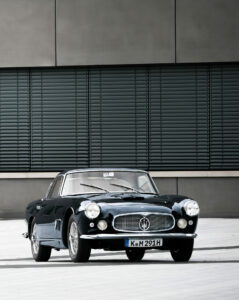
An intriguing 3500GT
This Maserati 3500GT #AM101.022 carries the aura of exclusivity with pride. It is a very early example of the company’s first actual production GT, born in an era when Maseratis were entirely handcrafted.
The passion and soul inevitably get lost when production is scaled up, and rationalisation and economic thinking take over. Even the most expensive, most illustrious vehicle faces economic concerns as soon as production runs of more than one are under consideration.
Proven throughout history, the very early cars are more beautiful, extravagant, extreme and artistic. In some cases, they are more powerful and faster but also less streamlined or reliable.
This Maserati 3500GT #AM101.022 carries the aura of exclusivity with pride. It is a very early example of the company’s first actual production GT, born in an era when Maseratis were entirely handcrafted..
BREEDING EXCLUSIVITY

To appreciate this car’s uniqueness, we reflect briefly on Italy’s automotive and industrial context in the late 1950s. By then, Europe had practically recovered from WW2, and in many countries, society accrued wealth. As a result, spending money on beautiful objects like extravagant cars became acceptable again.
Because of the war-related engineering efforts, car manufacturers and coachbuilders had new techniques and powerful engines at their disposal. This allowed them to cloth chassis frames with more extravagant and roomy curvature. Designers and coachbuilders focussed on shapes, design concepts and lavish interiors as weight was no longer a limiting factor. Safety regulations or economic considerations were still distant thoughts.
Boundless creativity flourished while labour rates in Italy were meagre compared to the rest of Europe. This context allowed the manufacturing of small numbers of complex body structures and tailor-made coachwork. These labour-intensive handcrafted pieces of art were combined with powerful, often race-bred engines.
Between 1926 and 1957, Maserati builds about 400 cars in total. Primarily sport and racing cars but also a few GTs which were basically upgraded sports cars with long-distance travelling capabilities but little comfort. The introduction of the 3500GT was Maserati’s first attempt to participate in a growing market niche asking for powerful, exclusive, comfortable GTs for long-distance touring.
Maserati conceptualised the 3500GT around a detuned 3500cc engine which won the Formula 1 championship in 1957. Rather than building everything in-house, the company took the logical and bold decision to source the best available components for the drive train, suspension, steering, etc.. externally and appointed Carozzeria Touring to build the coachwork.
Already in the late 1930s, Touring developed its famous ‘Superleggera’ concept. Founder Carlo Felice Bianchi Anderloni’s motto is: ‘Weight is the enemy; air resistance the challenge’. True to his words, the idea builds on a skeleton of thin steel tubes covered with beautifully shaped alloy panels. Throughout the 1940s, Touring integrated front and rear fenders and mudguards into fully closed envelopes. Then, with the arrival of the Alfa Romeo 1900SS bodywork, the shape of the later 3500GT began to ripen.
THIS PARTICULAR 3500GT
The 3500GT was Maserati’s first real commitment to enter the GT market. And this was when the company was in a dangerously weak financial position caused by malfortune, extraordinary high expenses for racing and troubled times in other Orsi companies. (Ed. Full story in Alfieri Magazine #4, page 14: ‘Why Maserati really quit racing’)
Maserati had limited human and financial resources to develop the new car at this time. As a result, the first cars were hand-built without even being close to a production standard and mainly without a standardised parts list. Different suppliers for parts and components, as well as different designs, were tested. Parts were used based on availability, and some components were likely sourced from the racing department.
All 3500GT/GTi Coupés usually have even chassis numbers. However, when production scaled, the numbering was not applied consistently, allowing for some odd numbers on cars. Furthermore, some very early chassis numbers were given to various coachbuilders, and some chassis apparently got lost. However, we know today that the prototype of all 3500GTs – La Dama Bianca – still exists and is under restoration in Italy. And chassis number 005 is undergoing restoration in Australia, which currently makes chassis number 022 the earliest Maserati 3500GT in running condition.
The car has undergone a detailed and ambitious restoration between 2013 and 2019, and the results is a very special 3500GT in top-notch condition. The chassis of the earliest cars differ as they have stronger, wider, more intricate sills and slightly more narrow width and track. AM101.022 carries dials and instruments from the Maserati A6, Alfin drum breaks and extremely rare Borrani wire wheels (RW3421).
The cylinder head and camshafts found in the engine are undoubtedly interesting. As with the 250F race car engines, the cylinder head has entry ports for cooling water circulation. Of course, this system is redundant today. However, it clearly hints at the cylinder head’s origin. In addition, the camshafts are profiled more aggressively than on other engines we have seen. Peak power is delivered between 3700 rpm and 4000 rpm, while standard engines have a flat torque curve of around 3000 rpm.
The engine revs quicker and more eagerly than in production units, enabling the car to reach an actual 217 km/h top speed.

When restoring chassis and coachwork, we could identify signs of ‘experimenting’ by the coachbuilder: unfinished welds, slots in the firewall, unused boreholes and various reinforcements not found on any standard 3500GT.
However, the most significant difference to all ‘standard’ 3500GT is the driving experience. The seating position is much more comfortable than in later cars allowing for more leg room due to slightly lower seat cushions and lower positioned sliders. The chassis is more rigid due to the stronger sills, and the steering is more precise. The engine revs quicker and more eagerly than engines in production units, enabling the car to reach an actual 217 km/h top speed. The dials and instruments are gorgeous, especially when the speedometer is revving.
The car feels like an actual sports car with a more aggressive DNA than the production cars.
It is often reasoned that pre-production cars are not finally developed and lack refinement. This is true for this car, but only in one particular area. The wind noise is louder than in later cars because they benefitted from superior gaskets around the side screens and A-pillar. But that is its only flaw. Because this car drives more lively and precise, it should have been the production standard.
THE RESTORER’S VIEW
I am very grateful this car was entrusted to my team and we were able to bring it back to a world-class standard. Doing so allowed us to learn about these early cars and appreciate the challenges the craftsmen at Touring and Maserati faced during building and assembly. We have tons of respect for these people. An enormous amount of flexibility, courageousness, across-the-board thinking, planning and handling was required without computer-aided design or simulation tools. The car is a tribute to their work.



DIGGING THROUGH THE ARCHIVES
In the factory records, we read that AM101.022 was assembled in February 1958. The original exterior colour is recorded as ‘blue’, and the interior as ‘red’. The shipping documents tell the car was delivered to Enrico Di Portanova on March 27, 1958. Portanova was an heir to the Hugh Roy Cullen estate and received at the time of the purchase a monthly allowance of $5.000.
Additional Maserati documents show upgrades were installed at the factory in Modena between 1960 and 1961, two years after it was built. This includes replacing the front drums with disc brakes and the original ZF gearbox (S4/30) with a 5-speed box.
Stickers on the rear screen indicate it was serviced in Palermo; later, it was shipped to the US.
There it was acquired by Charles Delia; Syosset, New York, on an unspecified date. He looked after the car, as proven by several repair bills and documents dating back to 1988. In 2010 the car was for sale at Gullwing Motors. In 2011, it returned to Europe via the Netherlands and in April 2013, the current owner bought it and commissioned a no-compromise +4000hrs restoration.
MEET ENRICO, THE CAR’S FIRST OWNER.

The irrepressible Baron Enrico di Portanova was one of the most flamboyant members of the international Jet Set, who once listed the best things in life as “sun, sex and spaghetti.” Enrico aka Ricky was born in Los Angeles between the 1930s and 1940s and spent the first years of his youth there.
However, Enrico and his brother Ugo, suffering from a severe mental handicap, were moved to Rome by his father, the Italian playboy Paolo Di Portanova. Father Paolo had divorced their mom Lillie Cranz Cullen, the second child of the American oil magnate Hugh Roy Cullen. He felt Italy was the best place to grow up.
Early in his life, Ricky’s unmistakable moustache, refined culture, love for women and engines, and all of life’s pleasures had already turned him into the golden boy. However, the death of his grandfather/oil magnate in 1957 and a sizable inheritance allowed him to step up his game for many years. However, in 1961, Ricky grasped the actual extent of his inheritance. His monthly endowment of $5,000 from the Cullen estate fund was no longer sufficient. So he left Rome and headed to America to claim his entire inheritance for himself and his brother Ugo.
In the late 1970s, after a long legal battle, his monthly income went up to $1.2 million, and his fortune went to $50 million. A final settlement with the Cullen fund in 1984 closed the discussion. From then on, Ricky was freed from any financial worries, so he dedicated his life to celebrating the pleasure of living in his residences in Rome, Houston, Montecarlo and Acapulco.
After a first stormy marriage, he remarried a voluptuous Texan girl in 1973, and they formed one of the most glamorous couples for 27 years. The “party” ended abruptly for both of them in 2000. Ricky died in February, and his wife followed in April, both cancer victims.






